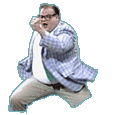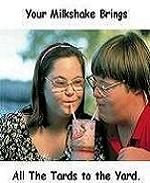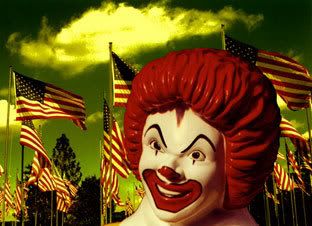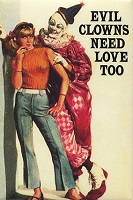The Pope is dead
Moderator: Dictators in Training
101 posts • Page 1 of 5 • 1, 2, 3, 4, 5
The Pope is dead
Mindia wrote:Yes Kizzy, and if given the opportunity I would love to SPIT in your face right now, you fucking PIG.
-

Diabolik - NT Bixie

- Posts: 0
- Joined: Sat Mar 27, 2004 8:18 am
- Location: Yo momma house
President Bush on Saturday called Pope John Paul II "a faithful servant of God and a champion of human dignity and freedom."
"He is an inspiration to us all," Bush said in his weekly radio address. "Laura and I join millions of Americans and so many around the world who are praying for the Holy Father."
http://www.catholic-pages.com/pope/election.asp
Popes are elected by the College of Cardinals meeting in Conclave when the Apostolic See falls vacant.
Pope Paul VI significantly changed the rules for conclaves in 1975 when he promulgated the Apostolic Constitution Romano Pontifico Eligendo. He excluded all cardinals 80 years old or over from the conclave and made provision to prevent any bugging of the Sistine Chapel.
It was according to these rules that Albano Luciano, Patriarch of Venice, was elected Pope John Paul I and that a little over a month later, Karol Wojtyla, Cardinal Archbishop of Krakow, was elected Pope John Paul II.
Pope John Paul himself promulgated a whole new set of rules in 1996 in the Apostolic Constitution Universi Dominici Gregis.
He has not departed radically from the traditional structure. But he has made some significant changes:
* if no cardinal has been elected by two-thirds majority after a certain number of ballots, the cardinals may agree by absolute majority (half + 1) to elect the Pope by an absolute majority instead of a two-thirds majority
* rather than stay in uncomfortable, makeshift quarters in the Papal Palace, the Cardinals will stay in the Domus Sanctae Marthae, hotel-style accommodation in Vatican City
* the only remaining method of electing the Pope is by scrutiny, ie, silent ballot -- the methods of election by acclamation and by committee have been excluded (but were rarely used)
* the older cardinals are still unable to enter the conclave, but they are invited to take an active role in the preparatory meetings
* the rules on secrecy are tougher
The maximum number of Cardinal Electors allowed at any one time is 120. The Pope cannot raise more than 120 men under 80 to the Cardinalate at any one time. (Of course, being Pope, he can also dispense himself with compliance with that rule! On the last two occasions, the Pope named new cardinals soon after the number of electors fell below 120. There were as high as 135 electors at some stages.) As at April 2005, there are 117 Cardinals eligible to vote in Conclave.
"He is an inspiration to us all," Bush said in his weekly radio address. "Laura and I join millions of Americans and so many around the world who are praying for the Holy Father."
http://www.catholic-pages.com/pope/election.asp
Popes are elected by the College of Cardinals meeting in Conclave when the Apostolic See falls vacant.
Pope Paul VI significantly changed the rules for conclaves in 1975 when he promulgated the Apostolic Constitution Romano Pontifico Eligendo. He excluded all cardinals 80 years old or over from the conclave and made provision to prevent any bugging of the Sistine Chapel.
It was according to these rules that Albano Luciano, Patriarch of Venice, was elected Pope John Paul I and that a little over a month later, Karol Wojtyla, Cardinal Archbishop of Krakow, was elected Pope John Paul II.
Pope John Paul himself promulgated a whole new set of rules in 1996 in the Apostolic Constitution Universi Dominici Gregis.
He has not departed radically from the traditional structure. But he has made some significant changes:
* if no cardinal has been elected by two-thirds majority after a certain number of ballots, the cardinals may agree by absolute majority (half + 1) to elect the Pope by an absolute majority instead of a two-thirds majority
* rather than stay in uncomfortable, makeshift quarters in the Papal Palace, the Cardinals will stay in the Domus Sanctae Marthae, hotel-style accommodation in Vatican City
* the only remaining method of electing the Pope is by scrutiny, ie, silent ballot -- the methods of election by acclamation and by committee have been excluded (but were rarely used)
* the older cardinals are still unable to enter the conclave, but they are invited to take an active role in the preparatory meetings
* the rules on secrecy are tougher
The maximum number of Cardinal Electors allowed at any one time is 120. The Pope cannot raise more than 120 men under 80 to the Cardinalate at any one time. (Of course, being Pope, he can also dispense himself with compliance with that rule! On the last two occasions, the Pope named new cardinals soon after the number of electors fell below 120. There were as high as 135 electors at some stages.) As at April 2005, there are 117 Cardinals eligible to vote in Conclave.
What saves a man is to take a step. Then another step.
– C. S. Lewis
– C. S. Lewis
-

Lyion - Admin Abuse Squad

- Posts: 14376
- Joined: Wed Mar 10, 2004 1:42 pm
- Location: Ohio
I heard that Nostradamus (spelling) predicted the Armageddon when the Pope dies. Start looking for signs!!!
Zanchief wrote:Harrison wrote:I'm not dead
Fucker never listens to me. That's it, I'm an atheist.
-

The Kizzy - NT Patron

- Posts: 15193
- Joined: Thu Mar 11, 2004 9:48 pm
- Location: In the closet with the ghosts
Kizzy wrote:I heard that Nostradamus (spelling) predicted the Armageddon when the Pope dies. Start looking for signs!!!
The signs are all about you. Hell we let Mindia, one of the four horsemen of the apocolypse back into NT. Let's see there is War, Famine, Ignorance, Death. Yup he is here among us.

-

kaharthemad - NT Traveller

- Posts: 3768
- Joined: Sat Mar 27, 2004 8:47 am
- Location: Somewhere South of Disorder
It is all myth. We build our own future. Stop putting all of your faith into books and put some if it into the power of God himself.
-

Gargamellow - Nappy Headed Ho

- Posts: 8683
- Joined: Wed Mar 10, 2004 5:39 am
- Location: Nunyafuggin Bidness
Lyion wrote:"He is an inspiration to us all," Bush said in his weekly radio address. "Laura and I join millions of Americans and so many around the world who are praying for the Holy Father."
Er... since when was the Pope the "Holy Father?" I thought that title belonged to someone much higher up...
*shrug* anywho, R.I.P. Pope John Paul II.
HyPhY GhEtTo MaMi wrote:GeT ofF mAh OvaRiEz
-

Trielelvan - NT Traveller

- Posts: 2745
- Joined: Wed Mar 10, 2004 1:11 pm
- Location: Mosquito central of da gr8 white nort'
I know. I heard them say that on TV last night and I just shook my head. I have no doubt this was a loving man who was generous and spiritual and forgiving. But I believe it is shit like that , that can bring the shit down on us.
-

Gargamellow - Nappy Headed Ho

- Posts: 8683
- Joined: Wed Mar 10, 2004 5:39 am
- Location: Nunyafuggin Bidness
Tadpole wrote:so what happens now
So, now they choose another old fat bald guy to be the successor to Peter. After all, it's up to the Vatican on who gets the keys to heaven next...

silly catholics
“The more I study science the more I believe in God.” -- Albert Einstein
- Narrock
- NT Patron

- Posts: 16679
- Joined: Mon Mar 15, 2004 11:54 pm
- Location: Folsom, CA
Not to start a religious debate here, and I apologize if I do, but doesn't the Bible say not to worship false idols? Wouldn't the Pope be a false idol?
Zanchief wrote:Harrison wrote:I'm not dead
Fucker never listens to me. That's it, I'm an atheist.
-

The Kizzy - NT Patron

- Posts: 15193
- Joined: Thu Mar 11, 2004 9:48 pm
- Location: In the closet with the ghosts
The pope isn't an idol, he's the head of the Church Peter started. You know, the guy Jesus said to: "You are Peter, and on this rock I will build my Church" in Matthew 16:18.
What saves a man is to take a step. Then another step.
– C. S. Lewis
– C. S. Lewis
-

Lyion - Admin Abuse Squad

- Posts: 14376
- Joined: Wed Mar 10, 2004 1:42 pm
- Location: Ohio
In the midnight hour, she cried more, more, more!
Here's a site with some great info on JP II.
http://www.theanchoress.blogspot.com/
Here's a site with some great info on JP II.
http://www.theanchoress.blogspot.com/
What saves a man is to take a step. Then another step.
– C. S. Lewis
– C. S. Lewis
-

Lyion - Admin Abuse Squad

- Posts: 14376
- Joined: Wed Mar 10, 2004 1:42 pm
- Location: Ohio
Diabolik wrote:Mindia wrote::balloons:
I'm shocked.
You fucking hypocrite.
Nonsense, the SDA thinks the pope is basically a sevant of Satan anyhow... what else would you expect?
--R.
Rust Martialis -- Spiritwatcher of War/Valorguard/The Nameless
"There are angels on our curtains; they keep the outside out.
And there are lions on our curtains; they lick their wounds, they lick their doubt." -- 'Curtains', Peter Gabriel
"There are angels on our curtains; they keep the outside out.
And there are lions on our curtains; they lick their wounds, they lick their doubt." -- 'Curtains', Peter Gabriel
- Rust
- NT Veteran

- Posts: 1127
- Joined: Thu Jun 24, 2004 8:37 pm
- Location: Toronto, ON
Mindia wrote:Good choice! Such a somber piece. That Requiem Mass was very powerful. He wrote that right after his father's death.
P.S. - Mozart was Catholic.
Mindia wrote:Yes Kizzy, and if given the opportunity I would love to SPIT in your face right now, you fucking PIG.
-

Diabolik - NT Bixie

- Posts: 0
- Joined: Sat Mar 27, 2004 8:18 am
- Location: Yo momma house
101 posts • Page 1 of 5 • 1, 2, 3, 4, 5
Who is online
Users browsing this forum: No registered users and 22 guests









